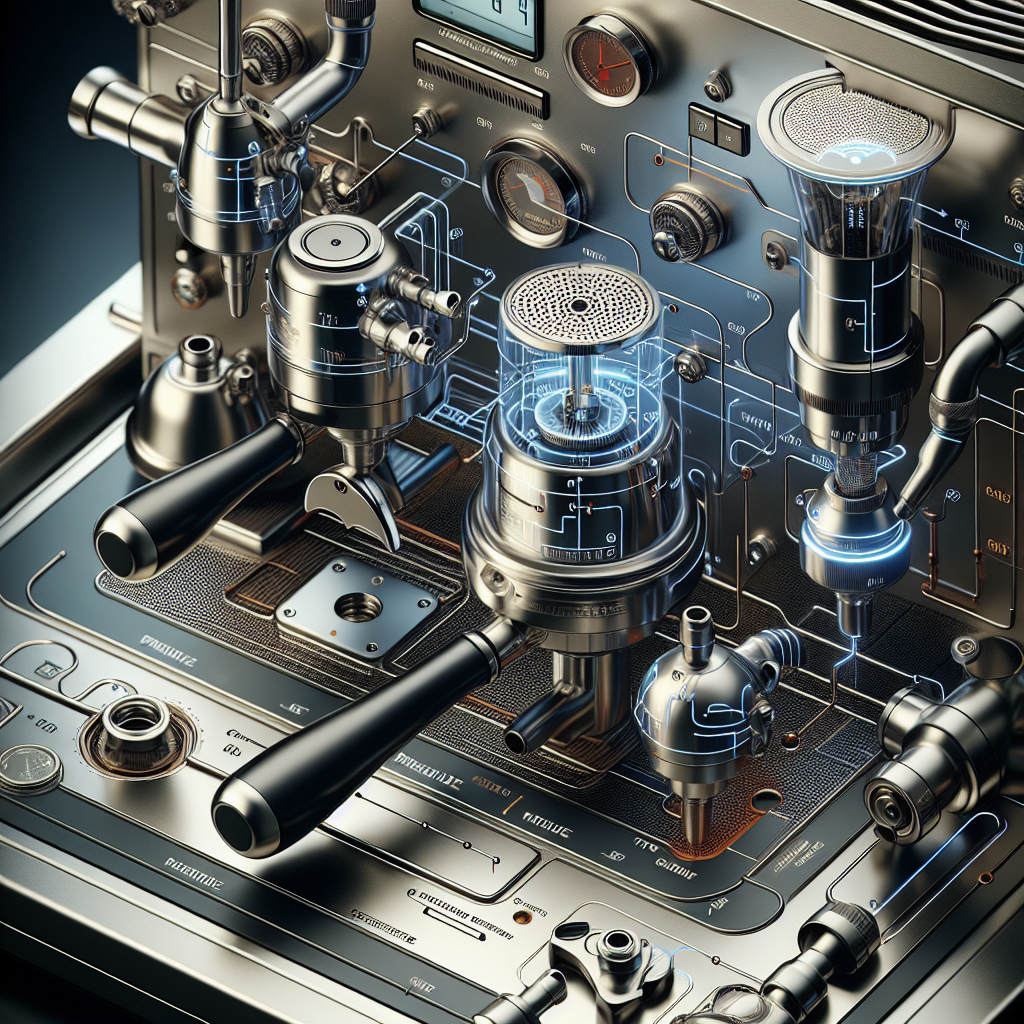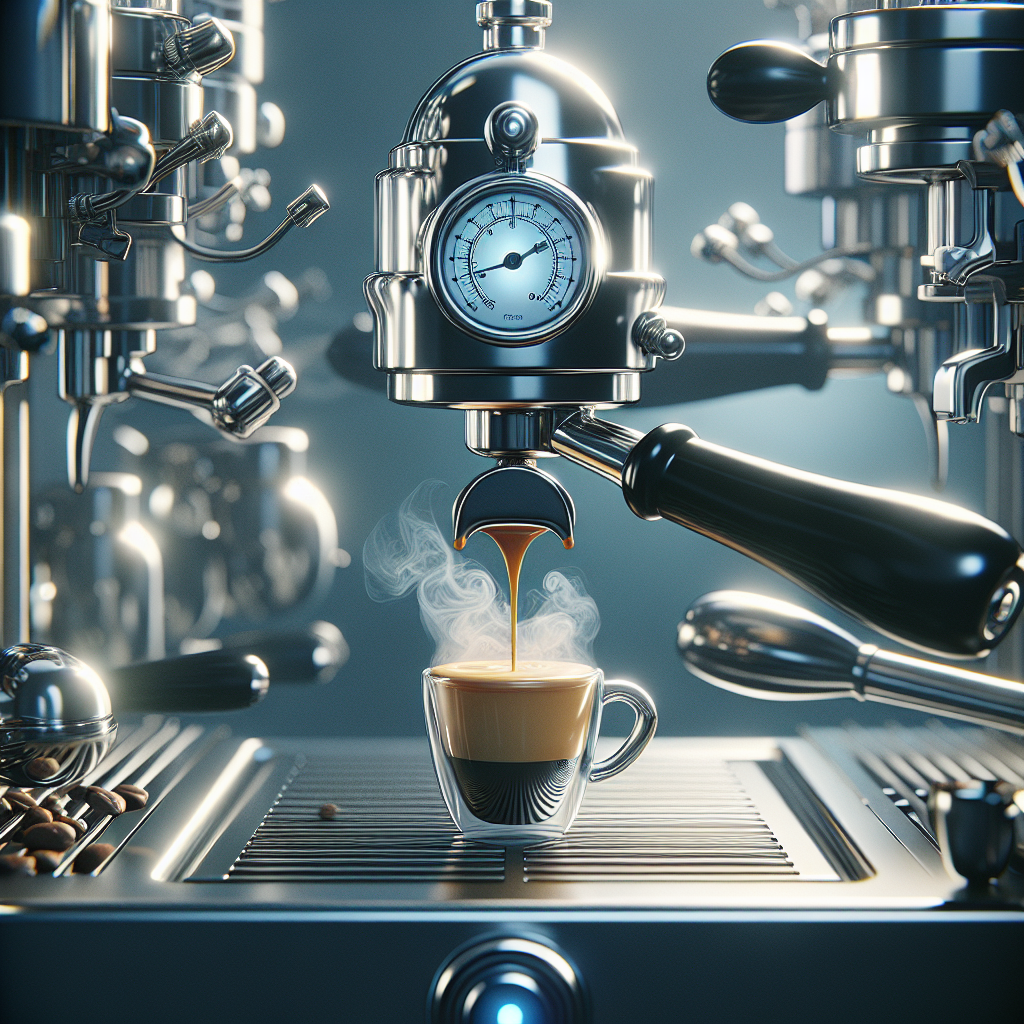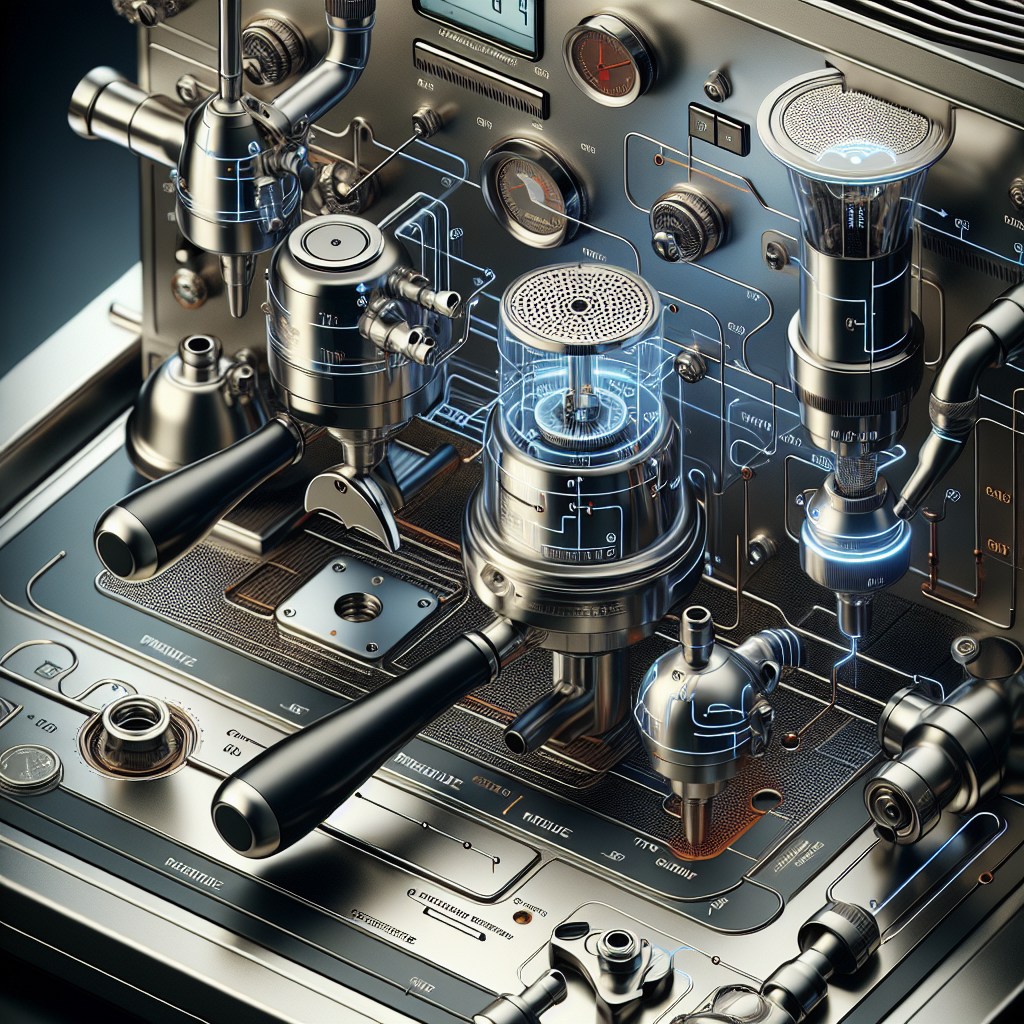
Imagine waking up on a crisp morning, craving that perfect cup of espresso to start your day. You walk over to your stainless steel espresso machine, its sleek design catching your eye. As you prepare your coffee grounds and water, you can’t help but wonder: what role does pressure play in creating the ideal cup of espresso with this machine? Pressure serves as the driving force behind the extraction process, determining the balance between bitterness and acidity in your brew. In this article, we will explore the ideal pressure range for stainless steel espresso machines, ensuring that every morning sip is a delight to your senses.

Understanding the Role of Pressure in Espresso Extraction
Introduction to pressure in espresso extraction
When it comes to brewing the perfect cup of espresso, pressure plays a crucial role in extracting the delicate flavors locked within coffee grounds. Espresso extraction is a complex process that requires precise control over various parameters, and pressure is one of the most important factors to consider. The aim of this article is to delve deeper into the significance of pressure in stainless steel espresso machines, explore the ideal pressure range, and understand its impact on the quality, crema formation, flavor profiles, consistency, longevity, and overall performance of your espresso.
The importance of pressure in extracting flavor compounds
Pressure is crucial in extracting the flavor compounds from coffee grounds and subsequently creating a rich, aromatic, and delicious shot of espresso. Espresso machines apply pressure to force hot water through the tightly packed bed of coffee grounds, extracting soluble compounds such as oils, acids, sugars, and other flavor components. The right amount of pressure helps to release these desirable compounds and create a well-balanced and full-bodied shot. Without adequate pressure, the extraction process would be incomplete, resulting in a weak and underwhelming cup of espresso.
Different types of pressure used in espresso machines
Espresso machines employ different types of pressure to achieve the desired extraction. The most common type is pump pressure, which is the pressure generated by a pump or motor-driven mechanism within the machine. This pump pressure is responsible for forcing water through the coffee grounds and into the cup. Another type of pressure used is pre-infusion pressure, which is a lower initial pressure that wets the coffee bed before applying full pressure. This technique allows for a more even extraction and enhances the flavors in the espresso. Understanding these different types of pressure and their roles in the extraction process is essential for achieving optimal results.
Ideal Pressure Range for Stainless Steel Espresso Machines
The standard pressure range for espresso extraction
For stainless steel espresso machines, the ideal pressure range for extraction typically falls between 8 and 9 bars. This standard pressure range has been widely accepted in the industry and is believed to produce the best results in terms of flavor and crema development. It is important to note that this range may vary slightly depending on the specific machine and the grind size of the coffee used. However, maintaining the pressure within this range is generally considered optimal for extracting the full range of flavors and achieving a balanced shot of espresso.
Factors influencing the ideal pressure range
Several factors influence the ideal pressure range for stainless steel espresso machines. One crucial factor is the grind size of the coffee. Finer grinds require higher pressure to ensure the water can pass through the bed of coffee evenly and extract the desired flavors. Coarser grinds, on the other hand, may require slightly lower pressure to avoid over-extraction. The type of coffee beans and their roast level can also impact the ideal pressure range. Lighter roasts may require higher pressure to fully extract the subtle flavors, while darker roasts may benefit from slightly lower pressure to prevent excessive bitterness. It is important to consider these factors when determining the ideal pressure range for your espresso machine.
Finding the sweet spot: experimentation and calibration
Finding the ideal pressure range for your stainless steel espresso machine often involves a process of experimentation and calibration. Every machine is unique, and factors such as temperature, humidity, and the age of the coffee can all contribute to variations in the extraction process. It is recommended to start with the standard pressure range of 8-9 bars and then make slight adjustments based on taste preferences and the characteristics of the specific coffee being used. Through trial and error, you can fine-tune the pressure to achieve the perfect balance of flavors, acidity, sweetness, and body in your espresso.
Effects of Different Pressure Levels on Espresso Quality
Under-extraction and low pressure
When the pressure during espresso extraction is too low, the result is under-extraction. Under-extracted espresso lacks complexity and depth of flavor, often tasting weak, sour, and watery. The low pressure fails to extract sufficient amounts of the desirable compounds, resulting in a shot that falls short of its true potential. The best way to remedy under-extraction is by increasing the pressure within the ideal range. This allows for a more complete extraction, resulting in a fuller-bodied and more flavorful cup of espresso.
Over-extraction and high pressure
On the other end of the spectrum, high pressure during extraction can lead to over-extraction. Over-extracted espresso tends to taste bitter, astringent, and overpowering. The excessive pressure pushes too much water through the coffee grounds, extracting undesirable compounds such as excess bitterness and unpleasant acidity. To counteract over-extraction, it is important to reduce the pressure within the ideal range. This adjustment helps to prevent the extraction process from extracting too many unwanted flavors, resulting in a smoother and more balanced cup of espresso.
Balancing extraction time and pressure for optimal results
Achieving the perfect cup of espresso requires finding the delicate balance between extraction time and pressure. While pressure plays a significant role, it must be in harmony with the extraction time. A longer extraction time with lower pressure can result in a more subtle and nuanced cup, while a shorter extraction time with higher pressure can produce a more intense and robust flavor profile. It is important to experiment with different combinations of pressure and extraction time to find the optimal balance that suits your taste preferences and the particular characteristics of the coffee used.
The Impact of Pressure on Crema Formation
Understanding the role of pressure in crema production
Crema, the luscious golden-brown foam that sits atop a well-brewed espresso shot, is not only visually appealing but also contributes to the overall taste and mouthfeel of the coffee. Pressure plays a fundamental role in the formation of crema. When the water is forced through the coffee grounds under the right pressure, it emulsifies the oils and creates tiny bubbles that give rise to the crema. The pressure should be sufficient to create a thick and creamy layer of crema, as it serves as a natural barrier to preserve the aroma and flavors within the espresso.
Achieving the right pressure for thick and creamy crema
To achieve a rich and flavorful crema, it is essential to maintain the pressure within the ideal range. Low pressure can result in thin and weak crema that dissipates quickly, while high pressure can lead to an excessive amount of crema that lacks the desired texture and taste. It is important to experiment with different pressures to find the sweet spot that produces a thick and creamy layer of crema. Additionally, factors such as the freshness of the coffee, grind size, and evenness of tamping can also influence the quality of the crema produced.
Common issues with crema and pressure
Inconsistent pressure during extraction can lead to various issues with crema formation. Too low pressure often results in sparse or uneven crema that fails to fully cover the surface of the espresso shot. Conversely, too high pressure can cause the crema to become excessively thick and bubbly, resembling a frothy meringue rather than a velvety crema. It is critical to ensure that the pressure is consistent throughout the extraction process to achieve a uniform and well-formed crema. Regular maintenance and calibration of your stainless steel espresso machine are essential to prevent variations in pressure and ensure the consistent production of high-quality crema.

Pressure Profiles and their Influence on Flavor
Exploring different pressure profiling techniques
Pressure profiling refers to the manipulation of pressure during the extraction process to achieve specific flavor profiles. Traditional espresso machines often maintain a constant pressure throughout the entire extraction, but advanced machines offer the ability to customize the pressure profile to enhance certain characteristics of the coffee. Different pressure profiles can highlight specific flavor notes, enhance sweetness or acidity, and create a more balanced and complex cup of espresso. By experimenting with pressure profiling techniques, baristas and enthusiasts can unlock a whole new world of flavor possibilities.
Pre-infusion and its effect on extraction
Pre-infusion is a pressure profiling technique that involves applying a lower pressure initially to saturate the coffee grounds and allow for a more even extraction. This technique mimics the natural blooming process that occurs when hot water first comes into contact with coffee grounds. Pre-infusion can enhance the sweetness, brightness, and overall flavor clarity of the espresso. By gradually increasing the pressure after pre-infusion, the extraction becomes more controlled and consistent, resulting in a well-rounded cup of espresso with balanced flavors.
Pressure ramps and pressure profiling options
Pressure ramps refer to the intentional variation of pressure throughout the extraction process. Some espresso machines offer the ability to program different pressure ramps, allowing you to create unique flavor profiles. For example, a gentle pressure ramp at the beginning of extraction can accentuate the acidity and brightness of the espresso, while a steeper pressure ramp towards the end can enhance the body and sweetness. These pressure profiling options provide a higher level of customization and allow for experimentation to achieve the desired flavor characteristics in your espresso.
Adjusting Pressure in Stainless Steel Espresso Machines
Manual vs. automatic pressure adjustment
Stainless steel espresso machines typically offer two options for adjusting pressure: manual and automatic. Manual adjustment involves manually altering the pressure settings using built-in controls or external pressure gauges. This allows for more hands-on control over the extraction process, allowing you to fine-tune the pressure based on taste preferences and specific coffee characteristics. Automatic pressure adjustment, on the other hand, relies on built-in mechanisms and sensors to regulate the pressure automatically. This can provide convenience and consistency, but may limit the ability to customize the pressure profile.
Calibrating pressure using built-in controls
Many stainless steel espresso machines come equipped with built-in controls that allow you to calibrate and adjust the pressure settings. These controls may include buttons, dials, or digital displays that allow you to increase or decrease the pressure within a certain range. Calibrating the pressure using these controls involves making small adjustments and monitoring the resulting taste and extraction quality. It is important to refer to the manufacturer’s instructions and guidelines for your specific machine to ensure proper calibration and avoid any potential damage.
Modifying pressure through machine modifications
For more advanced users and enthusiasts, modifying the pressure in stainless steel espresso machines can be an option to explore. This involves making mechanical or technical modifications to the machine to achieve the desired pressure range or pressure profiling capabilities. It is important to note that these modifications should only be attempted by experienced individuals or professionals, as improper modifications can lead to machine damage or safety hazards. Always consider the warranty and manufacturer’s guidelines before making any modifications to your espresso machine.
Importance of Consistency in Pressure
The role of consistent pressure in espresso quality
Consistency in pressure is paramount when it comes to producing high-quality espresso consistently. The pressure applied during extraction directly affects the final taste, aroma, and overall quality of the espresso. Inconsistent pressure can result in variations in extraction, leading to uneven flavor profiles and inconsistencies from shot to shot. Maintaining a consistent pressure allows for greater control over the extraction process and ensures that the desired flavor characteristics are consistently achieved.
Pressure variation and its impact on taste
Even minor variations in pressure during extraction can significantly impact the taste of the espresso. Fluctuations in pressure can lead to under-extraction or over-extraction, resulting in imbalanced flavors and an unpredictable taste experience. Inconsistent pressure can also affect the crema formation, mouthfeel, and overall texture of the espresso. To ensure a consistently delicious cup of espresso, it is crucial to monitor and maintain the pressure within the ideal range throughout each extraction.
Maintaining and monitoring pressure during extraction
To maintain consistent pressure, regular monitoring and maintenance of your stainless steel espresso machine are essential. Regularly check for any signs of pressure leaks or issues with the machine’s components, and promptly address any problems. It is also important to regularly clean and descale the machine to prevent build-up and clogs that can impact the pressure. Keeping a close eye on the pressure gauge or using advanced machines with pressure profiling capabilities can help you monitor the pressure during extraction and ensure consistency in every shot of espresso.
Pressure Maintenance and Safety Considerations
Regular maintenance routines for pressure components
Proper maintenance of the pressure components in your stainless steel espresso machine is crucial to ensure optimal performance and longevity. Regularly cleaning and descaling the machine helps prevent build-up and clogs that can affect the pressure and overall extraction quality. Additionally, it is important to inspect and replace any worn or damaged gaskets, valves, or seals to prevent pressure leaks or malfunctions. Following the manufacturer’s recommended maintenance routine and guidelines will help keep the pressure components in top condition for consistent and safe operation.
Avoiding pressure leaks and safety hazards
Pressure leaks in espresso machines can not only lead to inconsistent extraction but also pose safety hazards. It is essential to regularly inspect the machine for any signs of leaks, such as water pooling near the pressure components or steam escaping from unexpected areas. Addressing pressure leaks promptly can prevent equipment damage and ensure the safety of both the machine and the user. If you suspect a pressure leak, it is advisable to consult a professional or contact the manufacturer for assistance to avoid any potential risks.
Pressure relief mechanisms and their importance
Pressure relief mechanisms are safety features incorporated into espresso machines to prevent excessive pressure build-up and potential accidents. These mechanisms are designed to release built-up pressure safely and protect the machine from damage. They provide a safety net in case of any malfunctions or blockages that could lead to excessive pressure. Regularly inspecting and maintaining these pressure relief mechanisms is crucial to ensure their effectiveness and prevent any potential safety hazards during the extraction process.
Impact of Pressure on Longevity and Performance
Excessive pressure as a potential machine stress factor
While pressure is essential for espresso extraction, excessive pressure can pose a potential stress factor for stainless steel espresso machines. Continuous exposure to high pressure can strain the machine’s components, leading to wear and tear over time. It is important to avoid subjecting the machine to pressures beyond the manufacturer’s recommended range to prevent premature deterioration and mechanical failures. Adhering to the ideal pressure range and regular maintenance routines will help ensure the longevity and consistent performance of your stainless steel espresso machine.
Choosing the right pressure range for machine longevity
Selecting the appropriate pressure range for your stainless steel espresso machine is essential for maintaining its longevity and performance. It is crucial to consult the manufacturer’s guidelines and specifications to determine the recommended pressure range for your specific machine model. Exceeding this range can place unnecessary stress on the components, leading to potential damage or decreased lifespan. By operating the machine within the recommended pressure range, you can enjoy many years of reliable coffee brewing and extend the life of your beloved espresso machine.
Pressure-related issues and troubleshooting tips
Pressure-related issues can arise in stainless steel espresso machines, affecting the overall performance and extraction quality. Common problems include inconsistent pressure, pressure leaks, or difficulty maintaining the desired pressure during extraction. If you encounter any of these issues, first check for any visible signs of leaks, clogs, or worn-out components. Regularly cleaning and descaling the machine can help alleviate minor issues. If the problem persists or if you are unsure, it is always best to seek professional assistance or contact the manufacturer for troubleshooting guidance specific to your machine.
Conclusion
Understanding the role of pressure in stainless steel espresso machines is essential for brewing the perfect cup of espresso each time. Pressure plays a significant role in extracting the desirable flavor compounds, forming the crema, influencing the flavor profiles, and maintaining consistency in each extraction. Finding the ideal pressure range requires experimentation, calibration, and attention to factors such as grind size, coffee roast level, and the specific characteristics of the coffee used. Through continued experimentation, understanding, and maintenance, you can unlock the full potential of your stainless steel espresso machine and enjoy a truly satisfying espresso experience tailored to your preferences.